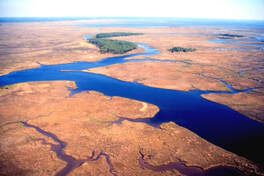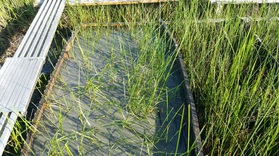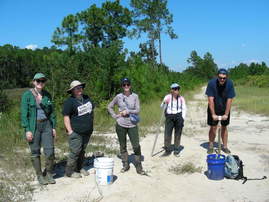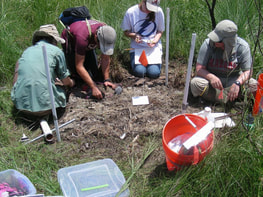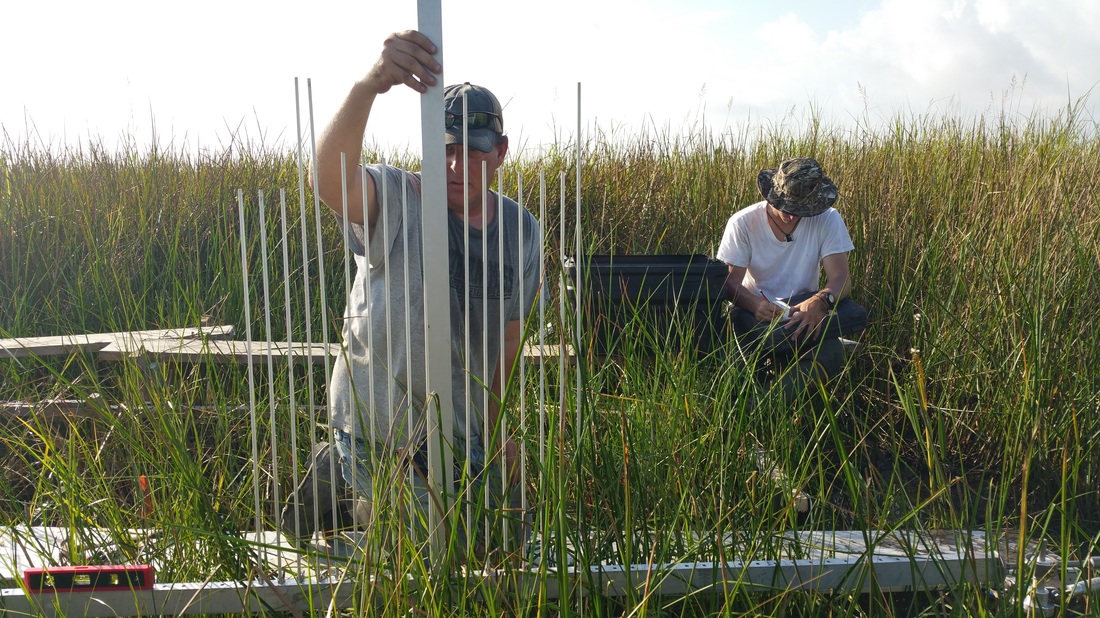Global Change Effects on Tidal Wetlands:
The goal of our coastal wetland research program is to understand the ways in which tidal wetlands respond to and maintain resilience in the face of environmental changes. In particular, we examine how simultaneously changing external forcing factors, such as elevated CO2, sea-level rise, nutrient enrichment, storm sedimentation, or fire, affect ecosystem processes that regulate carbon and nitrogen biogeochemistry, organic matter accumulation, vertical accretion, or the capacity for upslope migration. We combine greenhouse and field studies to (1) quantify biophysical feedbacks to marsh surface elevation; (2) examine impacts of disturbances or restoration on ecosystem structure and function; and (3) help inform models to promote adaptive management and restoration strategies.
Current & Recent Projects
|
Nature-based solutions and adjusted DEMs for marsh modelling activities
|
|
Understanding nonlinear responses of tidal marshes to sedimentation events through field and greenhouse experimentation
|
|
Recovering biological structure and ecosystem functions in restored tidal marshes of the northern Gulf of Mexico
|
|
Exploring the potential role of fire to promote lateral migration of coastal marsh in response to climate change
|
|
Forecasting tidal marsh responses to climate change and monitoring elevation change using Surface Elevation Tables (SETs).
|
|
|
|
Testing different restoration strategies aimed at recovering ecosystem functions in a world of rising seas using our weir approach.
|
Community Structure & Ecosystem Functions in Freshwater Wetlands:
To a lesser extent, we conduct research in local freshwater wetlands with the goal of understanding how plant communities respond to changes in their environment, interact with each other, and influence ecosystem processes. This work explores plant responses to invertebrate grazing, interspecific competition, and water level fluctuations. We also have examined how changes in community composition and liter quality influence patterns of nutrient or material export from beaver-formed wetlands embedded within larger stream networks.
Publications
Yannick, D., S. Oberbauer, C. Staudhammer, J.A. Cherry, and G. Starr. 2024. Carbon dynamics of a coastal wetland transitioning to mangrove forest. Journal of Geophysical Research-Biogeosciences. 129(4): e2023JG007991. https://doi.org/10.1029/2023JG007991
Starr, S.F., B. Mortazavi, C. Tatariw, K.A. Kuehn, J.A. Cherry, T. Ledford, E. Smyth, A.G. Wood, and S.E. Sebren. 2024. Labile organic matter promotes nitrogen retention in natural and constructed Gulf Coast marshes. Biogeochemistry. 167:169-285. https://doi.org/10.1007/s10533-024-01128-0.
Rinehart, S.A., J.M. Dybiec, P. Richardson, J.B. Walker, J.D. Peabody, and J.A. Cherry. 2024. Researcher effects on the biological structure and edaphic conditions of field sites and implications for management. Ecosphere. 15(1):e4750. https://doi.org/10.1002/ecs2.4750
Simpson, L.T., S.K. Chapman, L.M. Simpson, and J.A. Cherry. 2023. Do global change variables alter mangrove decomposition? A systematic review. Global Ecology and Biogeography. 32:1874-1892. https://doi.org/10.1111/geb.13743
Dybiec, J.M., M. Sharbaugh, S.A. Rinehart, and J.A. Cherry. 2023. Seasonal sediment dynamics in a constructed and natural tidal marsh in the northern Gulf of Mexico. Wetlands. 43:70. https://doi.org/10.1007/s13157-023-01719-x
Rinehart, S.A., J.M. Dybiec, E. Fromenthal, T. Ledford, B. Mortazavi, and J.A. Cherry. 2023. Recovery of planktonic invertebrate communities in restored and created tidal marshes along the northern Gulf of Mexico. Estuarine, Coastal and Shelf Science. 291: 108417. https://doi.org/10.1016/j.ecss.2023.108417
Rinehart, S.A., J.M. Dybiec, B. Mortazavi, and J.A. Cherry. 2023. Stratified vertical sediment profiles enhance burrowing crab effects on salt marsh edaphic conditions. Ecosphere. 14(3): e4431. https://doi.org/10.1002/ecs2.4431
Yu, Z., C. Staudhammer, S.L. Malone, S.F. Oberbauer, J. Zhao, J.A. Cherry, and G. Starr. 2022. Biophysical factors influence methane fluxes in subtropical freshwater wetlands using eddy covariance methods. Ecosystems. https://doi.org/10.1007/s10021-022-00787-0
Cherry, J.A. and G.J. Pec. 2022. Advances, applications, and prospects in aquatic botany. Applications in Plant Sciences. 10(4): e11488. https://doi.org/10.1002/aps3.11488
Starr, S.F., B. Mortazavi, C. Tatariw, K.A. Kuehn, J.A. Cherry, T. Ledford, E. Smyth, A.G. Wood, S.E. Sebren. 2022. Poor recovery of fungal denitrification limits nitrogen removal capacity in a constructed Gulf Coast marsh. Soil Biology and Biochemistry. 170:108692. https://doi.org/10.1016/j.soilbio.2022.108692
Pitchford, J. L., K. Cressman, J.A. Cherry, B.T. Russell, J. McIlwain, M.J. Archer, W.V. Underwood. 2022. Trends in surface elevation and accretion in a retrograding delta in coastal Mississippi, USA from 2012-2016. Wetlands Ecology and Management. 30:461-475. https://doi.org/10.1007/s11273-022-09871-7
Simpson, L.T., S.W.J. Canty, J. Cissell, M.K. Steinberg, J.A. Cherry, and I.C. Feller. 2021. Bird rookery nutrient over-enrichment as a potential accelerant of mangrove cay decline in Belize. Oecologia. 197(3):771-784. doi: 10.1007/s00442-021-05056-w.
Ledford, T.C., B. Mortazavi, C. Tatariw, S.F. Starr, E. Smyth, A.G. Wood, L.T. Simpson, and J.A. Cherry. 2021. Ecosystem carbon exchange and nitrogen removal rates in two 33-year-old constructed salt marshes are similar to those in a nearby natural marsh. Restoration Ecology. 29(7):e13439. https://doi.org/10.1111/rec.13439.
Macy, A., M. Osland, J.A. Cherry, and J. Cebrian. 2021. Effects of chronic and acute stressors on transplanted black mangrove (Avicennia germinans) seedlings along an eroding Louisiana shoreline. Restoration Ecology. 29(5):13373. https://doi.org/10.1111/rec.13373.
Martin, S., E.L. Sparks, A.J. Constantin, J. Cebrian, and J.A. Cherry. 2021. Restoring fringing tidal marshes for ecological function and ecosystem resilience to moderate sea-level rise in the northern Gulf of Mexico. Environmental Management. 67:384-397. https://10.1007/s00267-020-01410-5.
Wiesner, S., G. Starr, L.R. Boring, J.A. Cherry, P.C. Stoy, and C.L. Staudhammer. 2020. Forest structure and composition drive differences in metabolic energy and entropy dynamics during temperature extremes in longleaf pine savanna. Agricultural and Forest Meteorology. https://doi.org/10.1016/j.agrformet.2020.108252.
Tatariw, C., B. Mortazavi, T.C. Ledford, L.T. Simpson, S.F. Starr, E.L. Smyth, A.G. Wood, and J.A. Cherry. 2020. Reduced belowground plant recovery limited nitrate reduction capacity in a 32-year-old marsh. Restoration Ecology. https://doi.org/10.1111/rec.13300.
Macy, A., Osland, M.J., Cherry, J.A., and Cebrian, J. (2020) Changes in ecosystem nitrogen and carbon allocation with black mangrove (Avicennia germinans) encroachment into Spartina alterniflora salt marsh. Ecosystems. https://doi.org/10.1007/s10021-020-00565-w.
Simpson, L.T., Cherry, J.A., Smith, R.S., and Feller, I.C. (2020) Mangrove encroachment into saltmarsh alters decomposition through changes in litter quality. Ecosystems. https://doi.org/10.1007/s10021-020-00554-z.
Simpson, L.T., Lovelock, C.E., Cherry, J.A., and Feller, I.C. (2020) Short-lived effects of nutrient enrichment on Avicennia germinans decomposition in a saltmarsh-mangrove ecotone. Estuarine, Coastal and Shelf Science. 235:106598. https://doi.org/10.1016/j.ecss.2020.106598.
Cherry, J.A. and Battaglia, L.L. (2019) Tidal wetlands in a changing climate: introduction to a special feature. Wetlands. 39:1139-1144. doi.org/10.1007/s13157-019-01245-9.
Temple, N.A., Grace, J.B., and Cherry, J.A. (2019) Patterns of resource allocation in a coastal marsh plant (Schoenoplectus americanus) along a sediment-addition gradient. Estuarine, Coastal and Shelf Science. 228:106337. https://doi.org/10.1016/j.ecss.2019.106337.
Braswell, A.E., May, C.A., and Cherry, J.A. (2019) Spatially-dependent patterns of plant recovery and sediment accretion following multiple disturbances in a Gulf of Mexico tidal marsh. Wetland Ecology and Management. 27:377-392. https://doi:10.1007/s11273-019-09666-3.
Constantin, A.J., Broussard, W.P., and Cherry, J.A. (2019) Environmental gradients and overlapping ranges of dominant coastal wetland plants in Weeks Bay, AL. Southeastern Naturalist. 18:224-239.
Starr, G., Jarnigan, J., Staudhammer, C., and Cherry, J.A. (2018) Variation in ecosystem carbon dynamics of saltwater marshes in the northern Gulf of Mexico. Wetland Ecology and Management. 26:581-596.
Osland, M.J., Griffith, K.T., Larriviere, J.C., Feher, L.C., Cahoon, D.R., Enwright, N.M., Oster, D.A., Tirpak, J.M., Woodrey, M.S., Collini, R.C., Baustian, J.J., Breithaupt, J.L., Cherry, J.A., et al. (2017) Assessing coastal wetland vulnerability to sea-level rise along the northern Gulf of Mexico coast: gaps and opportunities for developing a coordinated regional sampling network. PLoS One 12(9):e0183431. [Link]
Lee, P.O., Cherry, J.A., Edmonds, J.W. (2017) Organic nitrogen runoff in coastal marshes: Effects on ecosystem denitrification. Estuaries and Coasts. 40:437-446. doi: 10.1007/s12237-016-0161-6.
Thompson, J.L., Kaiser, A., Sparks, E.L., Shelton, M., Brunden, E., Cherry, J.A., and Cebrian, J. (2016) Ecosystem-what? Public understanding and trust in conservation science and ecosystem services. Frontiers in Communication. 1(3):1-9. doi: 10.3389/fcomm.2016.00003. [PDF]
Jones, J.A., Cherry, J.A., and McKee, K.L. (2016) Species and tissue type regulate long-term decomposition of brackish marsh plants grown under elevated CO2 conditions. Estuarine, Coastal and Shelf Science. 169:38-45. https://doi.org/10.1016/j.ecss.2015.11.033.
Cherry, J.A., Ramseur, G.S. Jr., Sparks, E.L., and Cebrian, J. (2015) Testing sea-level rise impacts in tidal wetlands: a novel in situ approach. Methods in Ecology and Evolution. 6:1443-1451. doi: 10.1111/2041-210X.12441.
Conner, W.H. and Cherry, J.A. (2013) Plant productivity – bottomland hardwood forests. In Methods in Biogeochemistry of Wetlands, K.R. Reddy and R.D. DeLaune (eds). Soil Science Society of America, Madison, WI.
Woodrey, M.S., Rush, S.A., Cherry, J.A., Nuse, B.L., Cooper, R.J., and Lehmicke, A.J.J. (2012) Understanding the potential impacts of global climate change on marsh birds in the Gulf of Mexico region. Wetlands 32:35-49.
Cherry, J.A. (2011) Ecology of wetland ecosystems: water, substrate, and life. Nature Education Knowledge 2(1):3.
Cherry, J.A. and Gough, L. (2009) Trade-offs in plant responses to herbivory influence trophic routes of production in a freshwater wetland. Oecologia 161:549-557.
Cherry, J.A., McKee, K.L., and Grace, J.B. (2009) Elevated CO2 enhances biological contributions to elevation change in coastal wetlands by offsetting stressors associated with sea-level rise. Journal of Ecology 97:67-77.
Langley, J.A., McKee, K.L., Cahoon, D.R., Cherry, J.A., and Megonigal, J.P. (2009) Elevated CO2 stimulates marsh elevation gain, counterbalancing sea-level rise. Proceedings of the National Academy of Sciences 106:6182-6186. [PDF]
McKee, K.L. and Cherry, J.A. (2009) Hurricane Katrina sediment slowed elevation loss in subsiding brackish marshes of the Mississippi River Delta. Wetlands 29:2-15.
Cherry, J.A., Ward, A.K., and Ward, G.M. (2009) The dynamic nature of land-water interfaces: changes in structure and productivity along a water depth gradient in the Talladega Wetland Ecosystem. Verh. Internat. Verein. Limnol. 30:977-980.
Valentine-Rose, L.M., Cherry, J.A., Culp J.J., Perez, K.E., Pollock, J.B., Arrington, D.A., and Layman, C.A. (2007) Floral and faunal differences between fragmented and unfragmented Bahamian tidal creeks. Wetlands 27:702-718.
Cherry, J.A. and Gough, L (2006) Temporary floating island formation maintains wetland plant species richness: the role of the seed bank. Aquatic Botany 85:29-36.
Starr, S.F., B. Mortazavi, C. Tatariw, K.A. Kuehn, J.A. Cherry, T. Ledford, E. Smyth, A.G. Wood, and S.E. Sebren. 2024. Labile organic matter promotes nitrogen retention in natural and constructed Gulf Coast marshes. Biogeochemistry. 167:169-285. https://doi.org/10.1007/s10533-024-01128-0.
Rinehart, S.A., J.M. Dybiec, P. Richardson, J.B. Walker, J.D. Peabody, and J.A. Cherry. 2024. Researcher effects on the biological structure and edaphic conditions of field sites and implications for management. Ecosphere. 15(1):e4750. https://doi.org/10.1002/ecs2.4750
Simpson, L.T., S.K. Chapman, L.M. Simpson, and J.A. Cherry. 2023. Do global change variables alter mangrove decomposition? A systematic review. Global Ecology and Biogeography. 32:1874-1892. https://doi.org/10.1111/geb.13743
Dybiec, J.M., M. Sharbaugh, S.A. Rinehart, and J.A. Cherry. 2023. Seasonal sediment dynamics in a constructed and natural tidal marsh in the northern Gulf of Mexico. Wetlands. 43:70. https://doi.org/10.1007/s13157-023-01719-x
Rinehart, S.A., J.M. Dybiec, E. Fromenthal, T. Ledford, B. Mortazavi, and J.A. Cherry. 2023. Recovery of planktonic invertebrate communities in restored and created tidal marshes along the northern Gulf of Mexico. Estuarine, Coastal and Shelf Science. 291: 108417. https://doi.org/10.1016/j.ecss.2023.108417
Rinehart, S.A., J.M. Dybiec, B. Mortazavi, and J.A. Cherry. 2023. Stratified vertical sediment profiles enhance burrowing crab effects on salt marsh edaphic conditions. Ecosphere. 14(3): e4431. https://doi.org/10.1002/ecs2.4431
Yu, Z., C. Staudhammer, S.L. Malone, S.F. Oberbauer, J. Zhao, J.A. Cherry, and G. Starr. 2022. Biophysical factors influence methane fluxes in subtropical freshwater wetlands using eddy covariance methods. Ecosystems. https://doi.org/10.1007/s10021-022-00787-0
Cherry, J.A. and G.J. Pec. 2022. Advances, applications, and prospects in aquatic botany. Applications in Plant Sciences. 10(4): e11488. https://doi.org/10.1002/aps3.11488
Starr, S.F., B. Mortazavi, C. Tatariw, K.A. Kuehn, J.A. Cherry, T. Ledford, E. Smyth, A.G. Wood, S.E. Sebren. 2022. Poor recovery of fungal denitrification limits nitrogen removal capacity in a constructed Gulf Coast marsh. Soil Biology and Biochemistry. 170:108692. https://doi.org/10.1016/j.soilbio.2022.108692
Pitchford, J. L., K. Cressman, J.A. Cherry, B.T. Russell, J. McIlwain, M.J. Archer, W.V. Underwood. 2022. Trends in surface elevation and accretion in a retrograding delta in coastal Mississippi, USA from 2012-2016. Wetlands Ecology and Management. 30:461-475. https://doi.org/10.1007/s11273-022-09871-7
Simpson, L.T., S.W.J. Canty, J. Cissell, M.K. Steinberg, J.A. Cherry, and I.C. Feller. 2021. Bird rookery nutrient over-enrichment as a potential accelerant of mangrove cay decline in Belize. Oecologia. 197(3):771-784. doi: 10.1007/s00442-021-05056-w.
Ledford, T.C., B. Mortazavi, C. Tatariw, S.F. Starr, E. Smyth, A.G. Wood, L.T. Simpson, and J.A. Cherry. 2021. Ecosystem carbon exchange and nitrogen removal rates in two 33-year-old constructed salt marshes are similar to those in a nearby natural marsh. Restoration Ecology. 29(7):e13439. https://doi.org/10.1111/rec.13439.
Macy, A., M. Osland, J.A. Cherry, and J. Cebrian. 2021. Effects of chronic and acute stressors on transplanted black mangrove (Avicennia germinans) seedlings along an eroding Louisiana shoreline. Restoration Ecology. 29(5):13373. https://doi.org/10.1111/rec.13373.
Martin, S., E.L. Sparks, A.J. Constantin, J. Cebrian, and J.A. Cherry. 2021. Restoring fringing tidal marshes for ecological function and ecosystem resilience to moderate sea-level rise in the northern Gulf of Mexico. Environmental Management. 67:384-397. https://10.1007/s00267-020-01410-5.
Wiesner, S., G. Starr, L.R. Boring, J.A. Cherry, P.C. Stoy, and C.L. Staudhammer. 2020. Forest structure and composition drive differences in metabolic energy and entropy dynamics during temperature extremes in longleaf pine savanna. Agricultural and Forest Meteorology. https://doi.org/10.1016/j.agrformet.2020.108252.
Tatariw, C., B. Mortazavi, T.C. Ledford, L.T. Simpson, S.F. Starr, E.L. Smyth, A.G. Wood, and J.A. Cherry. 2020. Reduced belowground plant recovery limited nitrate reduction capacity in a 32-year-old marsh. Restoration Ecology. https://doi.org/10.1111/rec.13300.
Macy, A., Osland, M.J., Cherry, J.A., and Cebrian, J. (2020) Changes in ecosystem nitrogen and carbon allocation with black mangrove (Avicennia germinans) encroachment into Spartina alterniflora salt marsh. Ecosystems. https://doi.org/10.1007/s10021-020-00565-w.
Simpson, L.T., Cherry, J.A., Smith, R.S., and Feller, I.C. (2020) Mangrove encroachment into saltmarsh alters decomposition through changes in litter quality. Ecosystems. https://doi.org/10.1007/s10021-020-00554-z.
Simpson, L.T., Lovelock, C.E., Cherry, J.A., and Feller, I.C. (2020) Short-lived effects of nutrient enrichment on Avicennia germinans decomposition in a saltmarsh-mangrove ecotone. Estuarine, Coastal and Shelf Science. 235:106598. https://doi.org/10.1016/j.ecss.2020.106598.
Cherry, J.A. and Battaglia, L.L. (2019) Tidal wetlands in a changing climate: introduction to a special feature. Wetlands. 39:1139-1144. doi.org/10.1007/s13157-019-01245-9.
Temple, N.A., Grace, J.B., and Cherry, J.A. (2019) Patterns of resource allocation in a coastal marsh plant (Schoenoplectus americanus) along a sediment-addition gradient. Estuarine, Coastal and Shelf Science. 228:106337. https://doi.org/10.1016/j.ecss.2019.106337.
Braswell, A.E., May, C.A., and Cherry, J.A. (2019) Spatially-dependent patterns of plant recovery and sediment accretion following multiple disturbances in a Gulf of Mexico tidal marsh. Wetland Ecology and Management. 27:377-392. https://doi:10.1007/s11273-019-09666-3.
Constantin, A.J., Broussard, W.P., and Cherry, J.A. (2019) Environmental gradients and overlapping ranges of dominant coastal wetland plants in Weeks Bay, AL. Southeastern Naturalist. 18:224-239.
Starr, G., Jarnigan, J., Staudhammer, C., and Cherry, J.A. (2018) Variation in ecosystem carbon dynamics of saltwater marshes in the northern Gulf of Mexico. Wetland Ecology and Management. 26:581-596.
Osland, M.J., Griffith, K.T., Larriviere, J.C., Feher, L.C., Cahoon, D.R., Enwright, N.M., Oster, D.A., Tirpak, J.M., Woodrey, M.S., Collini, R.C., Baustian, J.J., Breithaupt, J.L., Cherry, J.A., et al. (2017) Assessing coastal wetland vulnerability to sea-level rise along the northern Gulf of Mexico coast: gaps and opportunities for developing a coordinated regional sampling network. PLoS One 12(9):e0183431. [Link]
Lee, P.O., Cherry, J.A., Edmonds, J.W. (2017) Organic nitrogen runoff in coastal marshes: Effects on ecosystem denitrification. Estuaries and Coasts. 40:437-446. doi: 10.1007/s12237-016-0161-6.
Thompson, J.L., Kaiser, A., Sparks, E.L., Shelton, M., Brunden, E., Cherry, J.A., and Cebrian, J. (2016) Ecosystem-what? Public understanding and trust in conservation science and ecosystem services. Frontiers in Communication. 1(3):1-9. doi: 10.3389/fcomm.2016.00003. [PDF]
Jones, J.A., Cherry, J.A., and McKee, K.L. (2016) Species and tissue type regulate long-term decomposition of brackish marsh plants grown under elevated CO2 conditions. Estuarine, Coastal and Shelf Science. 169:38-45. https://doi.org/10.1016/j.ecss.2015.11.033.
Cherry, J.A., Ramseur, G.S. Jr., Sparks, E.L., and Cebrian, J. (2015) Testing sea-level rise impacts in tidal wetlands: a novel in situ approach. Methods in Ecology and Evolution. 6:1443-1451. doi: 10.1111/2041-210X.12441.
Conner, W.H. and Cherry, J.A. (2013) Plant productivity – bottomland hardwood forests. In Methods in Biogeochemistry of Wetlands, K.R. Reddy and R.D. DeLaune (eds). Soil Science Society of America, Madison, WI.
Woodrey, M.S., Rush, S.A., Cherry, J.A., Nuse, B.L., Cooper, R.J., and Lehmicke, A.J.J. (2012) Understanding the potential impacts of global climate change on marsh birds in the Gulf of Mexico region. Wetlands 32:35-49.
Cherry, J.A. (2011) Ecology of wetland ecosystems: water, substrate, and life. Nature Education Knowledge 2(1):3.
Cherry, J.A. and Gough, L. (2009) Trade-offs in plant responses to herbivory influence trophic routes of production in a freshwater wetland. Oecologia 161:549-557.
Cherry, J.A., McKee, K.L., and Grace, J.B. (2009) Elevated CO2 enhances biological contributions to elevation change in coastal wetlands by offsetting stressors associated with sea-level rise. Journal of Ecology 97:67-77.
Langley, J.A., McKee, K.L., Cahoon, D.R., Cherry, J.A., and Megonigal, J.P. (2009) Elevated CO2 stimulates marsh elevation gain, counterbalancing sea-level rise. Proceedings of the National Academy of Sciences 106:6182-6186. [PDF]
McKee, K.L. and Cherry, J.A. (2009) Hurricane Katrina sediment slowed elevation loss in subsiding brackish marshes of the Mississippi River Delta. Wetlands 29:2-15.
Cherry, J.A., Ward, A.K., and Ward, G.M. (2009) The dynamic nature of land-water interfaces: changes in structure and productivity along a water depth gradient in the Talladega Wetland Ecosystem. Verh. Internat. Verein. Limnol. 30:977-980.
Valentine-Rose, L.M., Cherry, J.A., Culp J.J., Perez, K.E., Pollock, J.B., Arrington, D.A., and Layman, C.A. (2007) Floral and faunal differences between fragmented and unfragmented Bahamian tidal creeks. Wetlands 27:702-718.
Cherry, J.A. and Gough, L (2006) Temporary floating island formation maintains wetland plant species richness: the role of the seed bank. Aquatic Botany 85:29-36.

